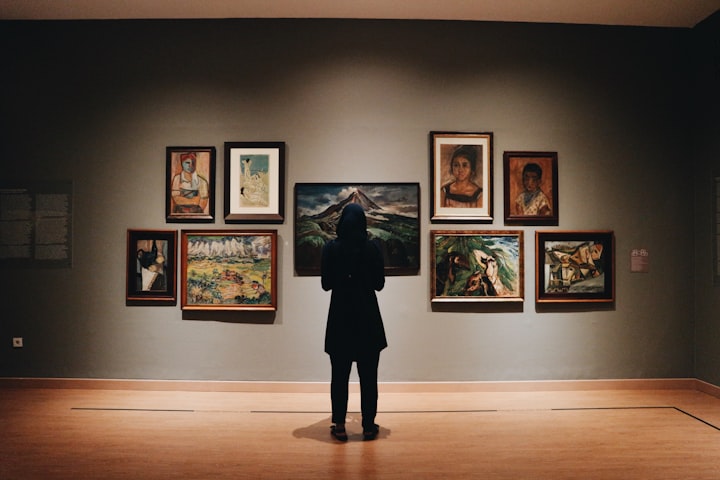Is the Art Market a Scam?
And I'm not talking about disappearing Banksies

In 2005, a Salvator Mundi believed a replica was auctioned off from the property of Baton Rouge industrialist Basil Clovis Hendry Sr. at the St. Charles Gallery auction house in New Orleans. It had been highly overpainted to the degree of looking like a replica, and was characterised as “a wreck, dark and depressing” before restoration. The picture was purchased for $1,175 by a group of art dealers. The team thought there was a chance that this low-quality piece may be Leonardo’s long-lost original.
Martin Kemp, an art historian, was skeptical of the outcome, saying that the painting’s raw condition “is considerably better than the one painted by Dianne.” The image was later identified as a Leonardo painting.
The painting was displayed in Hong Kong, London, San Francisco, and New York in 2017, before being auctioned for $450,312,500 (yes, millions) at Christie’s in NY on November 15, 2017, setting a new milestone price for an artwork. Saudi Arabian prince Badr bin Abdullah was named as the buyer.
This story may prompt the question: Why are people, rich people in particular, so ready to spend exorbitant amounts for artworks?
Starting from less controversial motives, art is not only delightful, but often a good investment. Sure, many assume that the art market can be taken as an indicator or imminent market bubbles, but fact is, buying the right stuff will assure it preserves or increases its value. While I would advocate for people to buy the art they like, a case could be made for which you could choose art pieces, much like other luxury goods, for monetary (though subjective) value.

On another note, the luxury art market is an oligarchy made of a few strong and wealthy players who know how to play the game.
As on 2022 65.1 billion U.S. dollars make up the yearly revenue of the art market. However, these are sold by a handful of auction houses and dealers to a similarly small pool of wealthy individuals.
The fact is, when prices are somewhat subjective, the field attracts a lot of people wanting to hack the game for gain.
So, what happens? Art dealers together with private galleries, journalists, historians and more, hype up certain new artists, or keep older ones relevant (this is not to say that every artist needs this process to be relevant, think of a Caravaggio…). Then again, because sellers can choose any price — remember, value is in the eye of the beholder — evaluators and auction houses have an easy time agreeing with high prices as the art piece is in demand.
An example of price manipulation in the art market can be found in the practice (legal) of Mugrabi and his Warhols. Mugrabi, a businessman and art collector, own around 1000 Andy Warhol’s pieces. He keeps the value of his collection up in various ways. For example, bidding high each time an Andy Warhol is on sale, even if he is not going to ultimately buy the piece. Actually, even when he does end up buying the piece, he still drives up the price during auctions. Why? To keep the artist’s oeuvre hyped up and relevant, and thus — or directly by buying at high prices — driving up the value of his collection.
Taxes, what?
At times, when all the hyping and rising prices are done, rich people with their accountants pass onto the next step.
Note: When reading about tax relief you’ll notice some similarities with the Warhol anecdote, but I am not assuming this is Mugrabi’s intention.
Once an artwork is relevant and desired, owners will sell the piece through auction houses (usually one of a few, e.g. Christie’s, Sotheby's and friends) and buy it again themselves for much more than what they bought it in the first instance.
Now that the net value of the artwork and their own assets have gone up, they don’t sell the artwork.
Nope, they “donate it”.

In short, the hyped artworks get bought again, but for more, from the sellers who then donate it to public institutions such as galleries and museums as “charitable giving”. This is how they evad…oops I mean, gain tax write-offs on their assets. And yes, we are usually talking millions.
Other times, people make use of artworks to straight up launder money.
There are several examples of art being used in money laundering schemes. Consider how the market crashed in less than a year after the Mexican government approved a rule requiring more information about purchasers and the amount of money that may be spent on a single piece of art in the early 2010s. Many speculated that this was due to the fact that Mexican cartel rings had previously been the market’s largest consumers.
Who pays the price?
I’m quite unsure of any connection between citizens tax money and the whole hyping-tax relief-laundering systems. But I do believe one thing.
The art world, artists, and art enthusiasts are those who pay the price for a system manipulated by billionaires, dealers, accountants, and whoever else is involved in these schemes.
Luckily, there are NFTs now. So a bigger amount of billionaires and millionaires can spend exorbitant amounts of money on images they could download as JPEG.






Comments
There are no comments for this story
Be the first to respond and start the conversation.